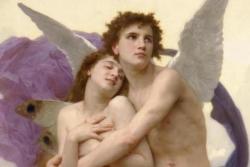Valentine's Day
 Two of the most easily recognised symbols of Valentine's Day are the heart shape and Cupid. Both of these symbols have their roots squarely planted in ancient Greece. Cupid is the name of the angelic cherub that inspires love by striking two people with his arrows of love. Although we have come to think of Cupid as a little child with pinchable rosy cheeks, the original Cupid was a Roman god. The ancient Romans plucked him straight out of Greek Mythology, as the origins for Cupid are in the Greek god Eros, god of love and sex, and the son of Aphrodite, goddess of love, lust and pleasure. Eros was represented in ancient Greek texts and art as a young adult male, irresistable to both humans and gods. During the Roman period, Eros was rebranded as a cherubic Cupid that we know today.
Two of the most easily recognised symbols of Valentine's Day are the heart shape and Cupid. Both of these symbols have their roots squarely planted in ancient Greece. Cupid is the name of the angelic cherub that inspires love by striking two people with his arrows of love. Although we have come to think of Cupid as a little child with pinchable rosy cheeks, the original Cupid was a Roman god. The ancient Romans plucked him straight out of Greek Mythology, as the origins for Cupid are in the Greek god Eros, god of love and sex, and the son of Aphrodite, goddess of love, lust and pleasure. Eros was represented in ancient Greek texts and art as a young adult male, irresistable to both humans and gods. During the Roman period, Eros was rebranded as a cherubic Cupid that we know today.
 In the 19th century, Cupid started appearing on Valentine's Day cards and decorative items, more a symbol of love and romance than the lustful desire of the past. The word 'erotic' meaning related to romantic love, comes from the Greek god Eros. Psychologist Sigmund Freud built the principle of psychology, named after Psyche, the true love of Eros, out of the idea that everyone is motivated by the desire for love.
In the 19th century, Cupid started appearing on Valentine's Day cards and decorative items, more a symbol of love and romance than the lustful desire of the past. The word 'erotic' meaning related to romantic love, comes from the Greek god Eros. Psychologist Sigmund Freud built the principle of psychology, named after Psyche, the true love of Eros, out of the idea that everyone is motivated by the desire for love.
 There are many theories about where the heart shape originated, the shape began to gain popularity around the time that Chaucer began to change the perception of Saint Valentine, which helped make it the Valentine's Day holiday event that we know today. However, the idea of the heart has long been associated with love, even before the ancient Greek philosopher Asistotle connected love to the human heart.
There are many theories about where the heart shape originated, the shape began to gain popularity around the time that Chaucer began to change the perception of Saint Valentine, which helped make it the Valentine's Day holiday event that we know today. However, the idea of the heart has long been associated with love, even before the ancient Greek philosopher Asistotle connected love to the human heart.
 In the third century, Roman priest Valentinius was brutally beaten and beheaded after marrying Christian and pagan couples in defiance of Emperor Claudius II's ban on the sacriment of marriage on this day in history, 14th February 270 AD. The execution of Valentinius committed to betrothal is celebrated around the world as Saint Valentine's Day, secularised in recent decades as just 'Valentine's Day', a holiday associated with red roses, jewellery gifts, chocolates, cards, hearts, teddy bears, romantic meals and romance.
In the third century, Roman priest Valentinius was brutally beaten and beheaded after marrying Christian and pagan couples in defiance of Emperor Claudius II's ban on the sacriment of marriage on this day in history, 14th February 270 AD. The execution of Valentinius committed to betrothal is celebrated around the world as Saint Valentine's Day, secularised in recent decades as just 'Valentine's Day', a holiday associated with red roses, jewellery gifts, chocolates, cards, hearts, teddy bears, romantic meals and romance.
The tale of Valentinius' martyrdom for uniting lovers in defiance of the emperor is one of several popular versions of the origin of Saint Valentine's Day, each rooted in truth but shrouded by two millennia of poorly recorded history.
The ancient Greeks had eight words that corresponded to different types of love:
 EROS Romantic, passionate love
EROS Romantic, passionate love- PHILIA Affectionate love
- AGAPE Selfless, universal love
- STORGE Familiar, family love
- MANIA Obsessive love
- LUDUS Playful love
- PRAGMA Enduring love
- PHILAUTIA Self love